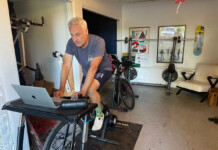If you live in the mountain west region, we are in for another hot summer. One way we cyclists like to escape the heat is by climbing canyon roads. With each gain of a couple of thousand feet of altitude, we can expect a welcome drop in temperature of 10-20°. Of course climbing a couple thousand feet is no easy task. Here are a few tips to make the climb a little more manageable and get you out of the valley heat.

To begin with, you need the right tool for the job. Make sure your bike is set up with adequate climbing gears. Few things will flatten your legs more quickly than stomping a massive gear. Try not to ‘save’ gears when you are climbing. Shift as you need to so you can maintain a quick, smooth cadence. Shoot for above 80 rpm and focus on pedaling nice smooth circles, not jagged squares. Stay ‘on top’ of the gear and avoid slow, heavy cadences. Try practicing 90 or 100+ rpm on flat terrain to develop the neuromuscular connection and make it easier to hold higher cadences on climbs. If you do not have adequate gearing to maintain a high cadence, check with your favorite shop to see if it is an easy swap to add gears to your bike. (i.e., a cassette with a larger cog and/or a compact crank).
Once you have the right tool for the job, there is a lot you can do with your body (even before dedicated training) to make the effort more manageable. As you settle into a long climb, keep your upper body relaxed. On a drop bar bike, you will usually want to have your hands on the tops of the bars or sometimes out on the hoods. There isn’t much reason to be in the drops when you are climbing. Bend from the hips to keep your back flat/straight and not rounded. As you do this, you should feel your glutes get more recruitment. Your glutes are big muscles so use them! Relax and open your shoulders to create more space in your chest and open your lungs. You want to be able to take deep breaths and fill up your lungs, rather than short shallow breaths into your chest. Keep your head up and look ahead for balance and focus. Keep your feet flat the whole way around the pedal stroke (do not pedal with your toes). As you do this you should feel your calves get more recruitment. Try standing on short pitches to stretch and stay on top of the gear instead of shifting down to spin up those pitches. Watch undulations in the grade of the road and shift in anticipation.
It is easy to charge into a climb and forget how hard it will be when fatigue starts to catch up. Break climbs into thirds for pacing strategy. Break them up using anticipated time (not mileage). For the first third, your main goal will be to hold yourself back a little. Spin easy gears and keep things conservative. In the second third of the climb, your effort will start to catch up and your goal is just to hold steady. In the final third, you will be feeling the effort and it’s time to empty the tank.
Climbing is hard work and you want to be well fueled for these kinds of efforts. Try to plan ahead and avoid eating too much right before or during the climb. Start with a solid meal before your ride and fuel in small bites and bits once you are into the climb. With lots of blood diverted from your belly to your working muscles, you may have a hard time digesting a large amount or heavy food so you want to start topped off and just keep up after that. Eat light and eat often as you climb. And remember to drink! Use an electrolyte mix like GU Brew to replace the electrolytes you are sweating out in the heat.
These tips give you a broad map to get you started.
For training protocol for climbing and all cycling goals, please contact Sarah for coaching.
Sarah Kaufmann is the owner of K Cycling Coaching based in Salt Lake City, UT. She is a professional XC and CX racer and can be reached at [email protected] or 413.522.3180.












Wexcellent advice
Comments are closed.